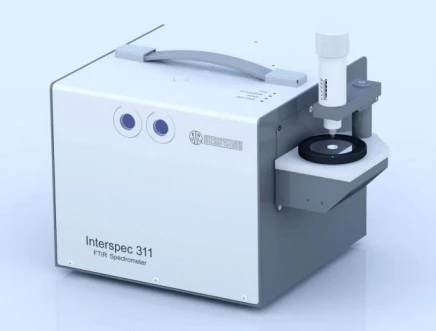Description
The Interspec 311 Compact FTIR Spectrometer is a cutting-edge analytical instrument designed for precision and reliability in spectroscopic analysis. Engineered to meet the demands of modern laboratories, this compact spectrometer offers a versatile solution for a variety of analytical needs. Its compact design ensures that it fits seamlessly into any laboratory setup without compromising on performance.
At the heart of the Interspec 311 is its advanced optical system, which provides a wide wavelength range from 7000 to 400 cm-1, expandable to 6000 to 600 cm-1 with the ZnSe ATR accessory. This flexibility makes it suitable for a broad spectrum of applications. The spectrometer boasts a high resolution of 2 cm-1, ensuring detailed and accurate spectral data. Its multicoated KBr beamsplitter and high-intensity air-cooled ceramic IR source are designed to deliver exceptional performance and longevity.
The Interspec 311 is equipped with a state-of-the-art data acquisition system featuring an 18-bit, high-speed interface, ensuring that data collection is both rapid and precise. The user-friendly Windows-based software interface, coupled with USB 2.0 connectivity, makes integration with existing laboratory systems straightforward and efficient. With its robust design and reliable components, the Interspec 311 is an ideal choice for laboratories seeking a high-performance FTIR spectrometer.
This spectrometer is powered by a 12 VDC, 30 W power supply, and its compact dimensions of W22xD21xH19 cm make it an excellent choice for laboratories with limited space. Weighing in at just 10 kg, it is easily portable, allowing for flexible placement and use. The Interspec 311 is a testament to Interspectrum OU's commitment to providing high-quality, innovative solutions for spectroscopic analysis.
Compact FTIR Spectrometer Interspec 311
Specifications
| Standard Measurement Range: | 7000 – 400 cm-1 |
|---|---|
| Max Resolution: | 2 cm-1 |
| Sample Handling: | 1 bounce ATR, transmission, reflection |
| Beamsplitter: | Multicoated KBr |
| Frequency Reference: | VCSEL laser |
| IR Source: | High intensity air cooled ceramic |
| Data Acquisition System: | 18 bit, high speed |
| Software: | Windows based |
| Interface: | USB 2.0 |
| Power: | 12 VDC, 30 W |
| Dimensions: | W22xD21xH19 cm |
| Weight: | 10 kg |
Features
- Compact Design: The Interspec 311 FTIR Spectrometer is designed to be compact and efficient, with dimensions of W22xD21xH19 cm and a weight of 10 kg, making it ideal for laboratory spaces.
- Wide Wavelength Range: Offers a standard wavelength range from 7000 to 400 cm-1, expandable to 6000 to 600 cm-1 with the ZnSe ATR accessory.
- High Resolution: Delivers a resolution of 2 cm-1, ensuring precise and accurate spectral data.
- Versatile Sample Handling: Supports multiple sample handling methods including 1 bounce ATR, transmission, and reflection.
- Advanced Beamsplitter: Equipped with a multicoated KBr beamsplitter for enhanced performance and durability.
- Reliable Frequency Reference: Utilizes a VCSEL laser for stable and accurate frequency referencing.
- Efficient IR Source: Features a high-intensity air-cooled ceramic IR source for consistent and reliable operation.
- High-Speed Data Acquisition: Incorporates an 18-bit high-speed data acquisition system for detailed and rapid data collection.
- User-Friendly Software: Comes with Windows-based software for easy operation and data analysis.
- Convenient Interface: Connects via USB 2.0, ensuring fast and reliable data transfer.
- Low Power Consumption: Operates on 12 VDC, 30 W, making it energy-efficient and cost-effective.
Applications
- Pharmaceuticals: Analyze and identify pharmaceutical compounds for quality control and assurance.
- Environmental Monitoring: Detect and quantify pollutants in air, water, and soil samples.
- Food and Beverage: Ensure product safety and quality by analyzing ingredients and contaminants.
- Petrochemicals: Monitor and analyze the composition of crude oil and its derivatives.
- Materials Science: Characterize materials such as polymers, coatings, and composites.
- Forensics: Identify substances and residues in forensic investigations.
- Academic Research: Facilitate research in chemistry, physics, and materials science.
- Biotechnology: Analyze proteins, lipids, and other biomolecules.
- Automotive: Analyze emissions and materials used in automotive manufacturing.
- Cosmetics: Ensure product safety and compliance by analyzing ingredients.
Frequently Asked Questions
What is the power requirement for the Interspec 311 FTIR spectrometer?
What is the spectral resolution of the Interspec 311 FTIR spectrometer?
What is the wavelength range of the Interspec 311 FTIR spectrometer?
What is the weight and dimensions of the Interspec 311 FTIR spectrometer?
What kind of sample handling does the Interspec 311 FTIR spectrometer offer?
Similar Products
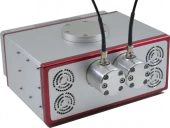
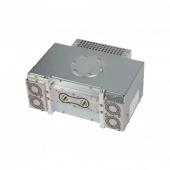
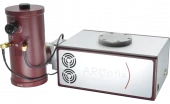


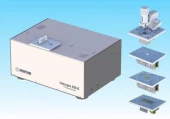
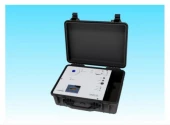

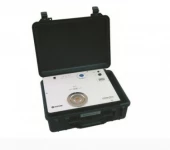

Your inquiry has been received.
Create an account by adding a password
Why create an account?
- Auto-complete inquiry forms
- View and manage all your past messages
- Save products to your favorites
- Close your account anytime — no hassle
